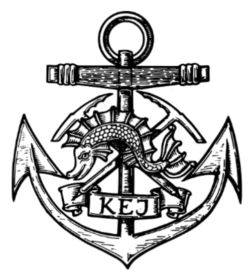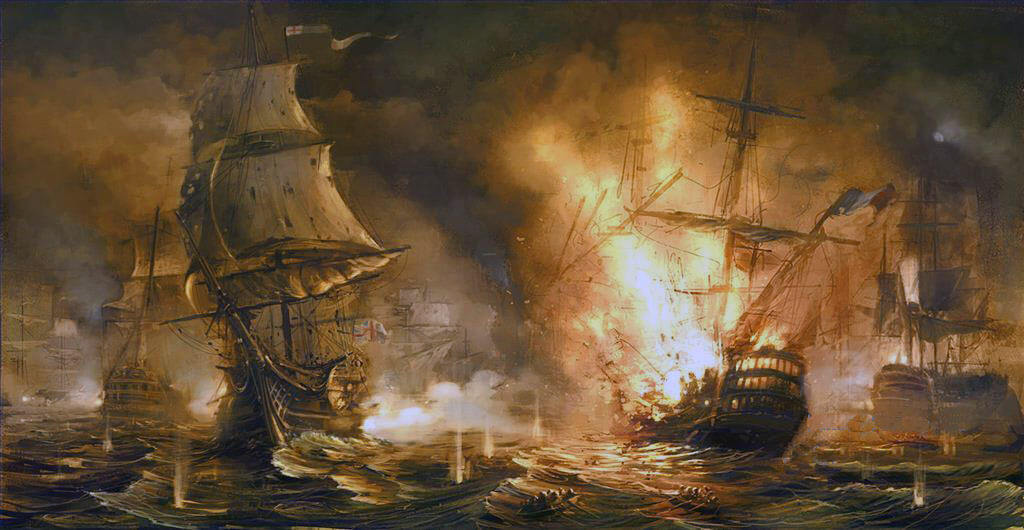By July 1798, Horatio Nelson was becoming increasingly frustrated and desperate to find Napoleon’s fleet. The French were now the dominant force in the Mediterranean, after the outbreak of war between Britain and Spain in 1796.
Nelson headed for Caramania (the Southern coast of Turkey), but finding no sign of the French fleet, once more turned away, heading west to Sicily, arriving around the 20th of July. Nelson, in a letter to Hamilton wrote that “the devil’s children have the devil’s luck” and that he was as ignorant of the enemies situation as he was twenty seven days before, in an increasingly exasperated letter.
At this point the French were, in fact, close to Alexandria, in Egypt.

Six days later after provisioning his fleet, and despite missing his frigates (then off North Africa), Nelson planned to leave Sicily and start the hunt once more, heading for the Archipelago, Constantinople, Cyprus or on to Egypt and Syria.
On the 29th of July, returning from the Gulf of Coron, Thomas Troubridge brought with him a captured French brig and the information that the French fleet had been spotted off Candia (modern day Crete) a few weeks beforehand.
Nelson knew where Napoleon was headed and immediately set sail for Alexandria, arriving on August the 1st. The British fleet sailed in to Aboukir Bay cleared for action. Seeing the French fleet, made up of 13 ships of the line and 4 frigates, a few miles ahead of them, including their flagship L’Orient, British gun crews were at battle stations and ready to fight…
The French fleet were aware of Nelson’s impending arrival and had been watching throughout the afternoon. Vice Admiral Brueys, onboard L’Orient had made the decision not to put to sea as he had an edge in firepower. Rear Admirals Blanquet de Chayla and Villeneuve also remained at anchor.
Brueys had considered how the battle would play out, believing that there would be an exchange of broadsides alongside the French line, but no chance of this being repeated as it would be darkness shortly.
At around 5 o’clock Brueys realised Nelson was coming for them and, despite seeing the signal flags, could not decipher them. The British were signalled to engage the van and centre of the enemy. They had been ordered to Anchor at the stern (back of the ship) in order to:
A. ensure that the ships were placed in the most advantageous spot alongside the enemy
and
B. make use of the wind, which blew down the French line, pushing them towards other targets.

Nelson’s plan? Lead with an attack on the French ships to his right, and try to eliminate them from the battle as quickly as possible. At the same time, he would be attacking the French centre with the remainder of his ships, hoping to annihilate the French fleet.
Nelson led by example, his fleet knew that he was determined to ‘conquer or perish in the attempt’ and his men respected him for it. He was not afraid to lay his life on the line and his leadership style is well respected to this day.
The French fleet, unaware of what was about to happen, perhaps with minimal foresight, perhaps not fearing a loss, chose not to rig their ships with springs, allowing them to manoeuvre and bring their guns to bear on ships attacking from the stern and stem. They did not consider that the shoals did not bother Nelson, nor did they expect an attack like Nelson had planned. They saw the British fleet breaking in to two lines and realised that it was a double headed strike. Hoisting their colours, they began to open fire at around 1730 from around 500yds away.
The British held their course, HMS Goliath sailed round the French ship Guerrier’s stem and fired a double shot in to her, with around 70 cannon balls traversing the full length of her gun decks. She then anchored by the Conquerant and engaged her. At around 1830, the British took on the Guerrier again, from HMS Zealous causing immense damage. HMS Orion was next and anchored by the French ship, Peuple Souverain after passing HMS Goliath and HMS Zealous. HMS Theseus then followed, passing HMS Zealous and HMS Goliath, firing on the two French ships as she passed before anchoring off of the Spartiate. HMS Audacious then took on the Guerrier before anchoring between her and the Conquerant. Nelson anchored at around 1830 near the Spartiate, before being passed by Minotaur and Defence who were going after L’Aquilon and Peuple Souverain.
At this point, this was all going on within a half mile area, to put it into perspective. Nelson had gained not only the advantage of catching the French fleet by surprise, but he had realised that if a ship has room to swing, it has room to anchor, and this was used to his advantage. A mix of simplicity and talent meant that Nelson had the upper hand. He transferred leadership and responsibility to those below him, who were able to use their initiative. This was something that followed him throughout his career.
By the time darkness fell, Troubridge had run aground on the shoal and Nelson was one ship down. HMS Alexander and HMS Swiftsure were delayed, but the French fleet were suffering. Guerrier, Conquerant and Spartiate were dismasted and Peuple Souverain and L/Aquilon struck colours and were taken by the British.
The centre attack did not go as well. As night fell, Bellerophon was alongside L’Orient and was dismasted also, before they cut the anchor cables, allowing them to drift away from the action. The odds were against Nelson, but by the time HMS Alexander and HMS Swiftsure arrived and brought their guns on to L’Orient and Franklin. L’Orient was taking fire at around 2110 and eventually blew up at 2200. The French centre was broken, meaning the British were to shift their focus on to the rear. By this point, Brueys was dead, Blanquet was wounded and Villeneuve was too far to the rear to be able to recognise his ships, the French did not have lights distinguishing them from each other and fired upon their own ships in the dark.

By dawn, victory for Nelson was certain, but he started the battle once more to ensure this. The British were tired, the French did not want to continue, but Nelson signalled HMS Goliath, HMS Zealous, HMS Majestic and HMS Alexander to join HMS Theseus, form a line and face Heureux, Mercure, Genereux, Timoleon, Guillaume Tell, La Justine and La Diane. By the end of the morning’s action, the Heureux and Mercure ran aground and took down their colours, Timoleon steered for the coast, but was abandoned and set on fire. The remaining French ships cut their cables and set sail. HMS Zealous engaged them, and was the final ship to fire shots as part of the battle. Nelson recalled the fleet, after a battle lasting around 19 hours.
After The Battle
The news of Nelson’s victory took time to reach Britain, and many did not want to believe rumours of a victory. Eventually, news of Nelson’s victory reached Britain on the 2nd of October. The French fleet had been virtually eliminated with 11 of their 13 ships sunk or burnt. The British did not lose one. It removed French naval influence in the Mediterranean and for the British it was the largest naval victory of the war so far, strategically damaging the French far more than the Glorious First of June, Camperdown or Cape St Vincent. Nelson was given the title of Baron, becoming Baron Nelson of The Nile and of Burnham Thorpe in the County of Norfolk. Nelson had achieved the fame he had looked for, he was present with swords, had poems written about him and his victory and the newspapers made him a hero with the people of Britain.

